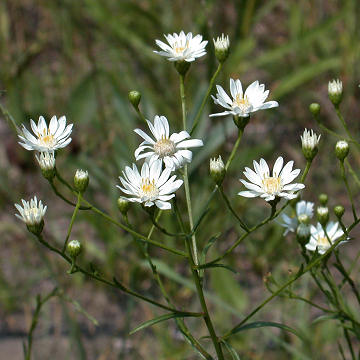

Solidago ptarmicoides - (image 1 of 6)
Taxonomy
Family: Asteraceae
Synonyms include Aster ptarmicoides (Nees) Torr. & A. Gray, Oligoneuron album (Nutt.) G.L. Nesom and Unamia ptarmicoides (Nees) Greene. Can hybridize with other species of Solidago.
Habitat
Prairies and other dry, open places. Prefers sandy or gravelly, calcareous soil.
Associates
Distribution
VT, NY, and western Quebec south to GA, west to Saskatchewan, CO, and AR.
Morphology
Herbaceous perennial to 0.7 m. Leaves firm and coriaceous (leathery), glabrous or scabrous, entire or with a few projecting teeth, usually 3-nerved; lower leaves tend to be larger, linear to narrowly lanceolate and petiolate, persistent; upper leaves gradually reduced and becoming sessile. Heads 3-60 in open flat or flattish-topped, corymbiform inflorescences; involucral bracts glabrous, imbricate, firm, often with a strongly thickened midrib; ray white, 5-9 mm; disk flowers whitish, numerous; pappus bristles clavellate-thickened and subplumose towards the tip.
Notes
Flowers mid June to early October
Wetland indicator: Facultative
Could easily be mistaken for an Aster due to the large, white ray petals. The clavate (club-like) pappus bristles are a good diagnostic feature. Most other Goldenrods have smaller rays that are yellow. Solidago bicolor L. is the only other species with white flowers in our area. Endangered in several states.
References
Gleason, Henry A. and A. Cronquist. 1991. Manual of Vascular Plants of
Northeastern United States
and Adjacent Canada. Second Ed.
The New York Botanical Garden. Bronx, NY
Swink, F. and G. Wilhelm. 1994. Plants of the Chicago Region.
Indiana Academy of Science. The Morton Arboretum. Lisle, Illinois.
USDA, NRCS. 2002. The PLANTS Database, Version 3.5 (http://plants.usda.gov).
National Plant Data Center, Baton Rouge, LA 70874-4490 USA.
|
Michael Hough © 2009 |